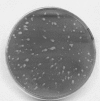Frequency of spontaneous mutations that confer antibiotic resistance in Chlamydia spp
- PMID: 15980362
- PMCID: PMC1168699
- DOI: 10.1128/AAC.49.7.2865-2873.2005
Frequency of spontaneous mutations that confer antibiotic resistance in Chlamydia spp
Abstract
Mutations in rRNA genes (rrn) that confer resistance to ribosomal inhibitors are typically recessive or weakly codominant and have been mostly reported for clinical strains of pathogens possessing only one or two rrn operons, such as Helicobacter pylori and Mycobacterium spp. An analysis of the genome sequences of several members of the Chlamydiaceae revealed that these obligate intracellular bacteria harbor only one or two sets of rRNA genes. To study the contribution of rRNA mutations to the emergence of drug resistance in the Chlamydiaceae, we used the sensitivities of Chlamydia trachomatis L2 (two rrn operons) and Chlamydophila psittaci 6BC (one rrn operon) to the aminoglycoside spectinomycin as a model. Confluent cell monolayers were infected in a plaque assay with about 10(8) wild-type infectious particles and then treated with the antibiotic. After a 2-week incubation time, plaques formed by spontaneous spectinomycin-resistant (Spc(r)) mutants appeared with a frequency of 5 x 10(-5) for C. psittaci 6BC. No Spc(r) mutants were isolated for C. trachomatis L2, although the frequencies of rifampin resistance were in the same range for both strains (i.e., 10(-7)). The risk of emergence of Chlamydia strains resistant to tetracyclines and macrolides, the ribosomal drugs currently used to treat chlamydial infections, is discussed.
Figures
References
-
- Andersson, D. I., and B. R. Levin. 1999. The biological cost of antibiotic resistance. Curr. Opin. Microbiol. 2:489-493. - PubMed
-
- Andrews, J. M. 2001. Determination of minimum inhibitory concentrations. J. Antimicrob. Chemother. 48(Suppl. 1):5-16. - PubMed
-
- Bartkus, J. M., B. A. Juni, K. Ehresmann, C. A. Miller, G. N. Sanden, P. K. Cassiday, M. Saubolle, B. Lee, J. Long, A. R. Harrison, Jr., and J. M. Besser. 2003. Identification of a mutation associated with erythromycin resistance in Bordetella pertussis: implications for surveillance of antimicrobial resistance. J. Clin. Microbiol. 41:1167-1172. - PMC - PubMed
Publication types
MeSH terms
Substances
Associated data
- Actions
- Actions
Grants and funding
LinkOut - more resources
Full Text Sources
Medical
Miscellaneous


